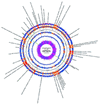Extensive mosaic structure revealed by the complete genome sequence of uropathogenic Escherichia coli
- PMID: 12471157
- PMCID: PMC139262
- DOI: 10.1073/pnas.252529799
Extensive mosaic structure revealed by the complete genome sequence of uropathogenic Escherichia coli
Abstract
We present the complete genome sequence of uropathogenic Escherichia coli, strain CFT073. A three-way genome comparison of the CFT073, enterohemorrhagic E. coli EDL933, and laboratory strain MG1655 reveals that, amazingly, only 39.2% of their combined (nonredundant) set of proteins actually are common to all three strains. The pathogen genomes are as different from each other as each pathogen is from the benign strain. The difference in disease potential between O157:H7 and CFT073 is reflected in the absence of genes for type III secretion system or phage- and plasmid-encoded toxins found in some classes of diarrheagenic E. coli. The CFT073 genome is particularly rich in genes that encode potential fimbrial adhesins, autotransporters, iron-sequestration systems, and phase-switch recombinases. Striking differences exist between the large pathogenicity islands of CFT073 and two other well-studied uropathogenic E. coli strains, J96 and 536. Comparisons indicate that extraintestinal pathogenic E. coli arose independently from multiple clonal lineages. The different E. coli pathotypes have maintained a remarkable synteny of common, vertically evolved genes, whereas many islands interrupting this common backbone have been acquired by different horizontal transfer events in each strain.
Figures



References
-
- Hooton T. M. & Stamm, W. E. (1997) Infect. Dis. Clin. North Am. 11, 551-581. - PubMed
-
- Manges A. R., Johnson, J. R., Foxman, B., O'Bryan, T. T., Fullerton, K. E. & Riley, L. W. (2001) N. Engl. J. Med. 345, 1007-1013. - PubMed
-
- Perna N. T., Plunkett, G., III, Burland, V., Mau, B., Glasner, J. D., Rose, D. J., Mayhew, G. F., Evans, P. S., Gregor, J., Kirkpatrick, H. A., et al. (2001) Nature 409, 529-533. - PubMed
-
- Blattner F. R., Plunkett, G., III, Bloch, C. A., Perna, N. T., Burland, V., Riley, M., Collado-Vides, J., Glasner, J. D., Rode, C. K., Mayhew, G. F., et al. (1997) Science 277, 1453-1474. - PubMed
Publication types
MeSH terms
Associated data
- Actions
Grants and funding
LinkOut - more resources
Full Text Sources
Other Literature Sources
Molecular Biology Databases

